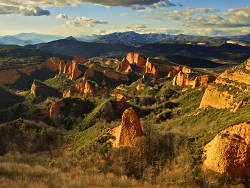Alluvial Deposit
An alluvial deposit is material deposited by rivers. It consists of loose sediments containing silt, sand, clay, and gravel, which is actually the same except for the grain size. It also contains organic matter, like plant remains or dead animals, and also microorganisms living in the groundwater. Extensive alluvial deposits can be found in the lower part of a river’s course, forming floodplains and deltas. These deposits are known to contain metals like gold, platinum, and tin, and also gemstones.

Sediments are deposits of debris of all sizes, which is formed by erosion. All kinds of geologic structures are eroded and transported, to be re-sedimented somewhere else. After some time, the sediments may become sedimentary rocks by a process called diagenesis. The deposits are generally not altered by diagenesis, so the following also applies to sedimentary rocks.
Many important and valuable minerals and ores are resistant against erosion, e.g. gold and diamonds. So the surrounding rock is eroded, but the valuable minerals or ores remain. They are accumulated and re-sedimented with the residuals of the surrounding rocks. During the transport, depending on the relative weight of the mineral, it is deposited in typical structures. Because of its weight, gold is transported by water only if the water has very high energy, for example during floods. As soon as the energy of the water lowers, the heavy minerals are deposited first. The result is a graded layering, where the gold is concentrated at the bottom. This may happen various times, with the result of various gold bearing layers at the bottom of each sequence.
Another typical structure is a placer. If there are depressions, they become traps for heavy components. The water is able to transport the mineral on flat ground, but not to lift it over the rim of the depression. The mineral accumulates in the depression. Such placers are highly concentrated, but generally rather small. Unfortunately, there is no overall structure, so it is not easy to find them.
However, in the case of gold, placers are often mined. Historically, the mining started by finding placers accidentally. Then the sediments were searched more or less shallow by washing the gold. This process is rather similar to the way the placers were formed.
There are quite similar deposits called colluvial deposits, which are often hard to keep apart, because they also consist of loose sediments. They were not transported by water, but by mass wasting and gravity which causes rock fragments, soil, and other debris to move downslope and accumulate at the base of slopes or in hollows. It’s not necessarily the result of a rockfall, but rockfall is probably a part of the formation process, as well as landslides and soil creep. The differences are a poorly sorted mix of particles, angular particles which wer not rounded by transport in water, and they are unstratified and chaotic.
While the weathering of rocks may free valuable components, the mechanical erosion does not sort the components, and so the heavier components are not accumulated. As a result, there might be resources in the sediment, but it’s much more effort necessary to mine it. Colluvial deposits are thus of less economic value.
 Placer Mining
Placer Mining Search DuckDuckGo for "Alluvial Deposit"
Search DuckDuckGo for "Alluvial Deposit" Alluvial deposit - Wikipedia
Alluvial deposit - Wikipedia Alluvial Deposit (visited: 26-MAR-2024)
Alluvial Deposit (visited: 26-MAR-2024)
 Index
Index Topics
Topics Hierarchical
Hierarchical Countries
Countries Maps
Maps